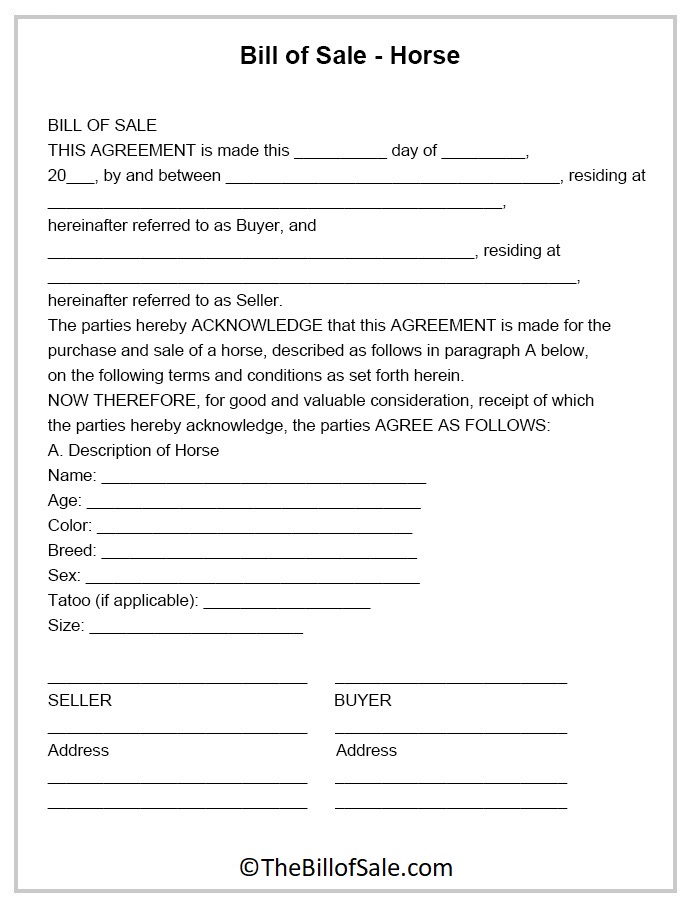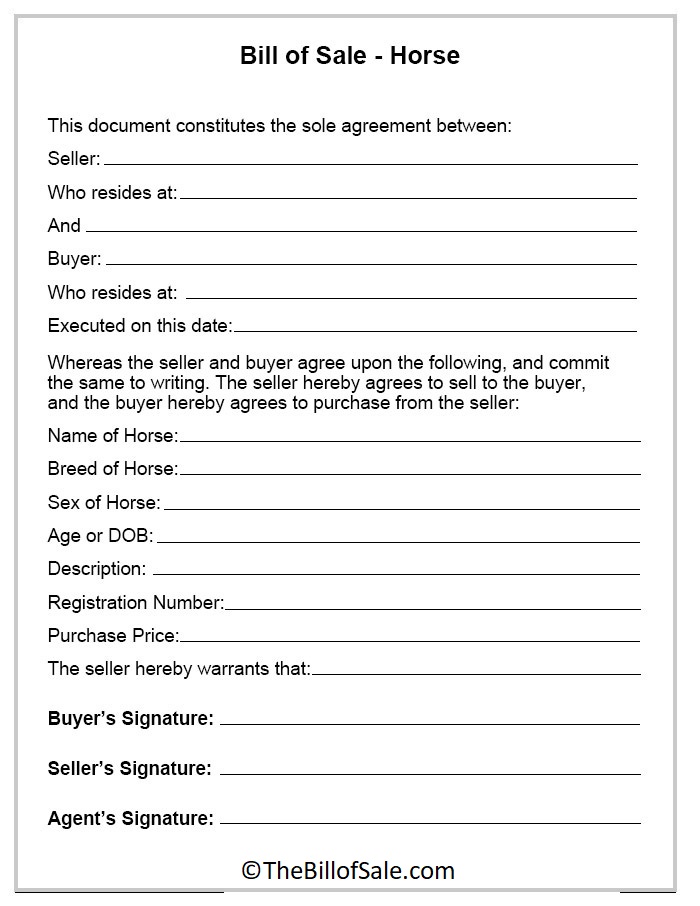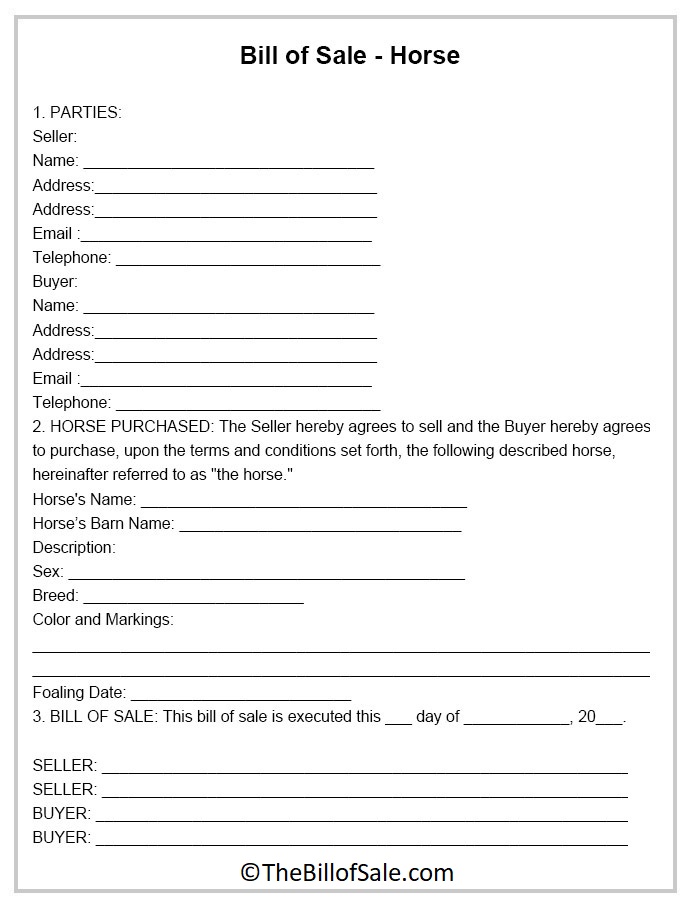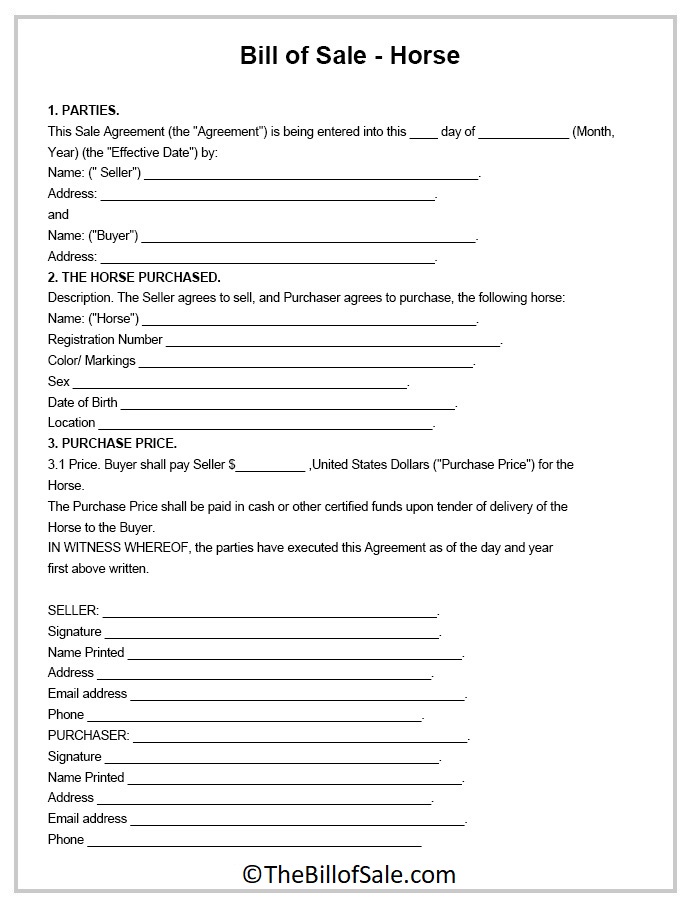Take a look at our printable template for the horse bill of sale form, which can be used to create a legally valid bill of sale. The Horse Bill of Sale form is a document specifically designed to record the legal sale of a horse. It is a mandatory requirement during the process of buying or selling a horse. Similar to other bill of sale forms, it serves as proof of the transfer of ownership for the horse.
Printable Horse Bill of Sale Form
The horse bill of sale form captures essential details about the horse, the seller, and the buyer, including information related to the horse’s health and condition. As mandated by the Animal Protection Act of the USA, this bill is mandatory nationwide. In the following discussion, we will delve further into the horse bill of sale to provide comprehensive information for all our readers.
Bill of Sale For Horse

Similar to any other bill of sale, it is crucial to utilize the form before transferring possession of the horse to the buyer. Typically, this bill is required prior to the buyer taking custody of the horse. This is because the bill must be completed first, including all the relevant information pertaining to the sale.
After the seller completes all the necessary information in the bill, the sale is finalized through the signatures of both the seller and the buyer.
How to Purchase a Horse?
Acquiring a horse involves following several steps to ensure a smooth process. Our aim is to simplify this procedure for our readers, enabling them to easily obtain the desired horse. Please refer to our step-by-step guide below:
Step 1 – Select the Horse Breed
Just like other animals, horses come in different breeds. It is essential to determine the specific breed you are interested in. If you are new to horse ownership, it is recommended to choose a calm and well-trained horse. Such horses are easier to handle and maintain.
Step 2 – Establish a Budget
Considering that horses are large animals requiring adequate space, it is important to assess your budget to accommodate their needs. Owning a horse entails expenses for items like a stable or barn. Therefore, budgeting accordingly is crucial.
Step 3 – Explore Local Horse Sellers
It is advisable to approach local horse dealers in your area. They possess knowledge about the local environment and can provide horses that are well-suited to specific geographical characteristics. You may also have the opportunity to choose your preferred horse breed and color.
Step 4 – Test Ride and Negotiate Price
Once you find a desired horse, it is recommended to take it for a test ride. This will give you insight into the horse’s temperament and riding capabilities, allowing you to assess whether you can handle it properly. After these evaluations, you can negotiate the final price with the seller.
Step 5 – Finalize and Complete the Sale
Once an agreement on the price is reached, you can proceed to finalize the sale. Utilize a form template to create the bill, ensuring that all necessary details are accurately filled in. Finally, both the buyer and seller must sign the bill to formalize the transaction.
How to Write the Bill of Sale for Horse ?
Writing can be confusing, especially for those without prior experience. To simplify the process, we have provided some straightforward steps to help you fill out the bill of sale easily.
Step 1 – Date and Parties
Begin the bill by stating the date at the top and include the names of the seller and buyer. Ensure that the correct addresses of both parties also included in the bill of sale.
Step 2 – Introduce the Horse
The horse is the focal point of the bill of sale. Include all relevant details about the horse, such as its gender, age, date of birth, breed, and any additional descriptions that may be necessary.
Step 3 – Specify the Sale Price
The sale price is a crucial aspect of the bill and should be clearly stated. Include the final price agreed upon for the sale, along with any details regarding a security deposit if applicable.
Step 4 – Execute the Sale with Signatures
To finalize the sale, both the seller and the buyer must sign the bill of sale. It recommend to have the bill notarized by a notary public. Once the bills signed and notarized, the buyer and seller can proceed with the exchange of the horse in return for the sale amount.
Horse Bill of Sale Form Template
By following these steps, both sellers and buyers can successfully complete the horse bill of sale and finalize the sale transaction. We hope that this article has provided valuable insights into the process of drafting. For added convenience, readers can also utilize a bill of sale template to simplify the task.
FAQs of Horse Bill of Sale
Q: What is a horse bill of sale?
It is a legal document that serves as evidence of the sale and transfer of ownership of a horse. It outlines the details of the transaction, including the buyer, seller, horse description, purchase price, and any additional terms or conditions.
Q: Why do I need a horse bill of sale?
It is crucial for both buyers and sellers as it provides a formal record of the horse’s sale and transfer of ownership. It helps protect the rights and interests of both parties involved and serves as proof of the transaction in case of any disputes or legal issues.
Q: What information should included in a horse bill of sale?
It should include the following information:
- Date of the bill of sale
- Full legal names and addresses of the buyer and seller
- Description of the horse, including its breed, gender, age, color, markings, and any other identifying details
- The purchase price or exchange of value
- Any warranties, guarantees, or conditions of the sale
- Signatures of both the buyer and seller, along with the date of signing
Q: Is a horse bill of sale legally binding?
Yes, a properly executed this is legally binding. It establishes a contractual agreement between the buyer and seller, outlining the terms and conditions of the sale. However, it recommend to consult with legal professionals or experts in equine law to ensure compliance with relevant regulations and to address any specific requirements in your jurisdiction.
Q: Do I need to notarize a horse bill of sale?
Notarization requirements may vary depending on the jurisdiction or specific circumstances. In some cases, notarization may required to add an additional layer of authenticity and legal validity. It is advisable to consult the local laws or seek legal guidance to determine if notarization is necessary.
Q: Can I use a template for a horse bill of sale?
Yes, using a template can be a convenient option for creating this form. Templates provide a structured format and guide you through including the necessary information. However, it is important to customize the template to accurately reflect the details of your specific horse sale and comply with applicable laws and regulations.
Q: Can a horse bill of sale be used for other animals?
No, Specifically designed for transactions involving horses. If you involved in the sale or transfer of ownership of other animals, it is advisable to use a specific bill of sale form or legal document appropriate for that particular species or type of animal.



